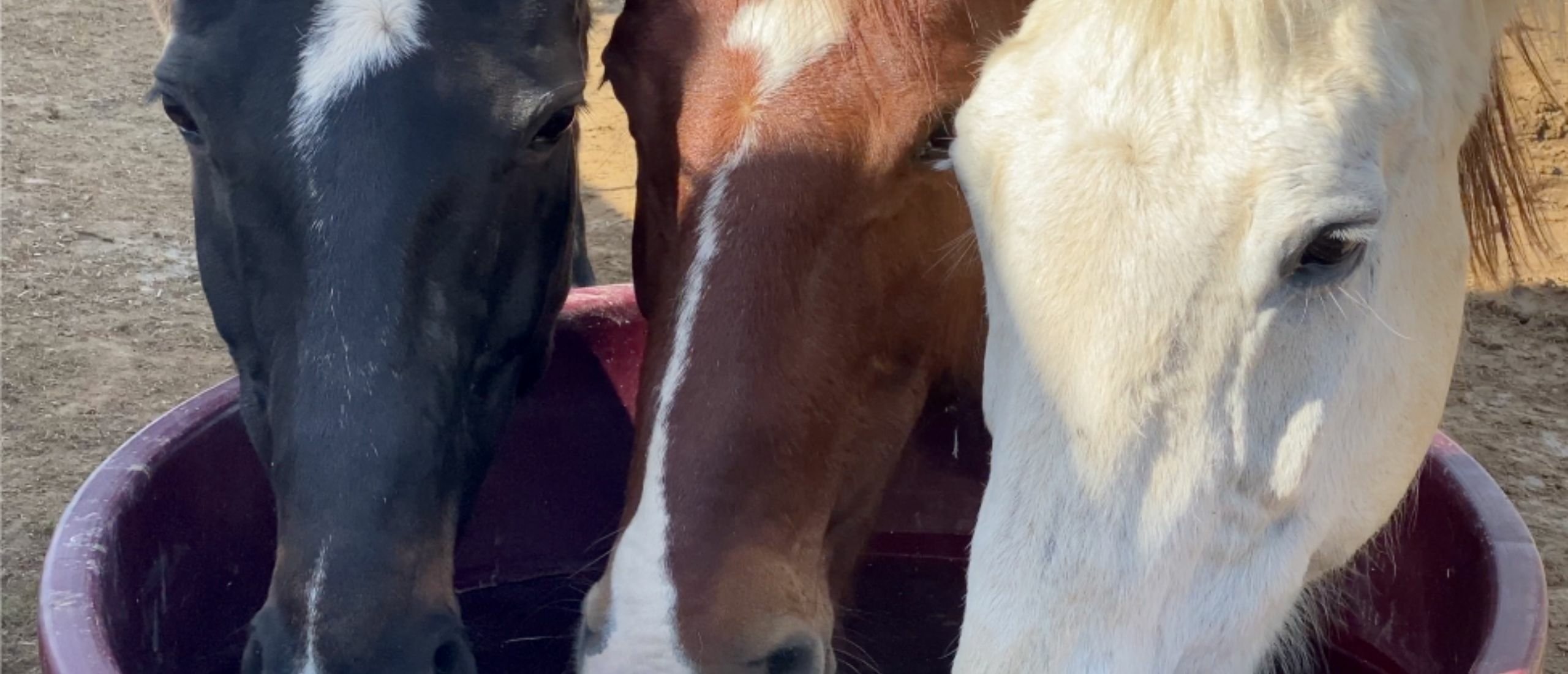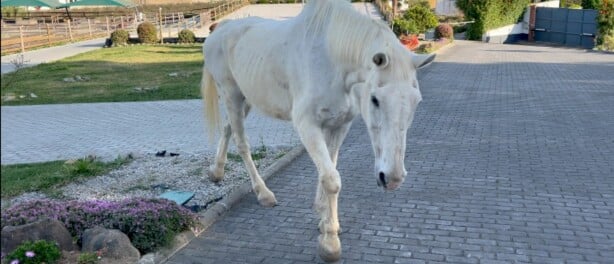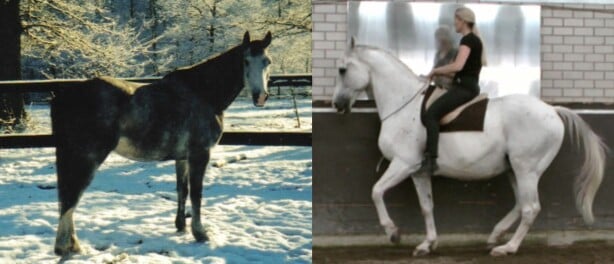Wolfee's socialization process went very well, and she started to feel very comfortable with her new friends, the horses:
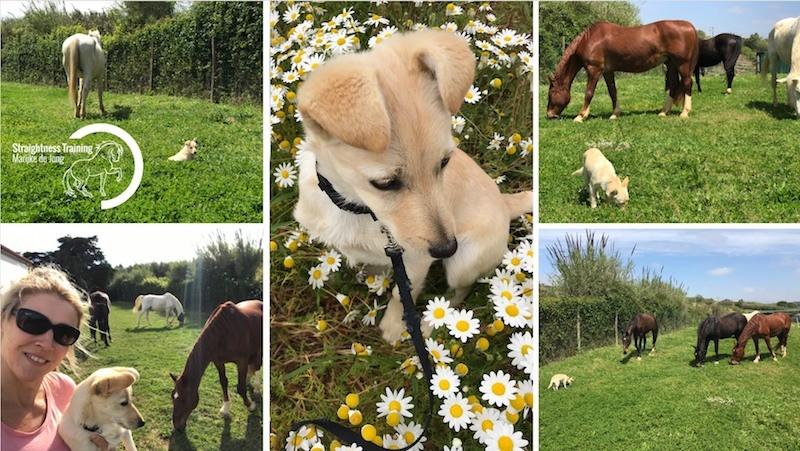
Now, Wolfee didn't have to say goodbye to her old friends, as they live on the other side of the road, so we can easily visit them:
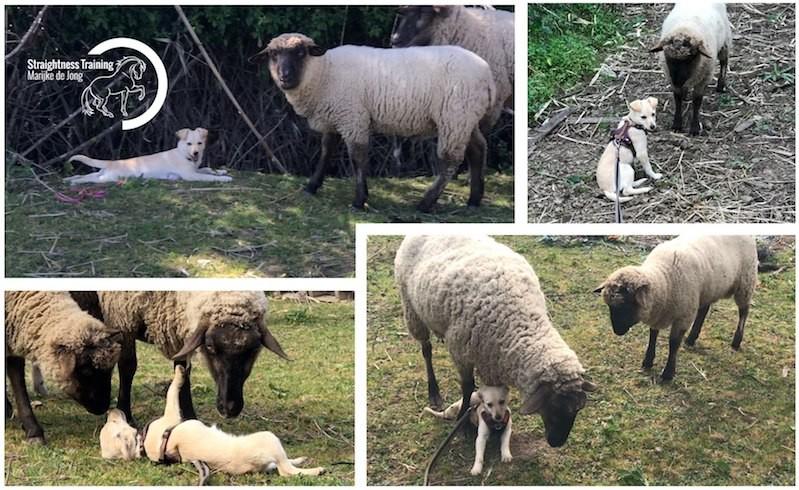
And we also spend much time hanging out with the horses.
Hanging Out With The Horses
Wolfee became less and less shy, and the horses got used to Wolfee's energy and enthusiasm as you can see in the video below.
Since Wolfee is a young, curious (and potentially bored) puppy who likes to chew on everything, I wanted to create a safe place where she could relax and feel secure at those moments I cannot 100% keep an eye on her. I also wanted to create a setting where she could be around when training the horses, because training the horses takes a few hours a day. Therefore, I created a "Happy Place" for Wolfee.
"Happy Place" Training
In the house, but also in the riding arena, I created "Happy Places" where Wolfee can relax, sleep, chew on toys, and watch the horses. It consists of a crate for guinea pigs, a cozy sheepskin to lay on, toys to chew on, water, and a sort of "bridge" to get into the crate. The crate is big enough for Wolfee to comfortably stand up, turn around, and lie down in with outstretched legs. Since young animals are very curious and like to join the party, it was very easy to get Wolfee moving onto the bridge, into the crate, and wait. It's just a matter of capturing the slighest try and slightest better with reinforcement.
In general, whatever you reinforce, you get more of that in the future, so after a few sessions, she almost ran into the crate and waited patiently. After she had a positive association with the crate, we worked on duration and distance. Gradually, Wolfee could stay a little longer in the crate, and gradually I also took more distant from her. To do so, I did a little bit of garden weeding in the beginning: first 1 minute, then 5 minutes, then 10 minutes. This way she got used to spending time a bit more on her own in the crate. When she stayed happily engaged with her toys, I made the duration longer or distance bigger.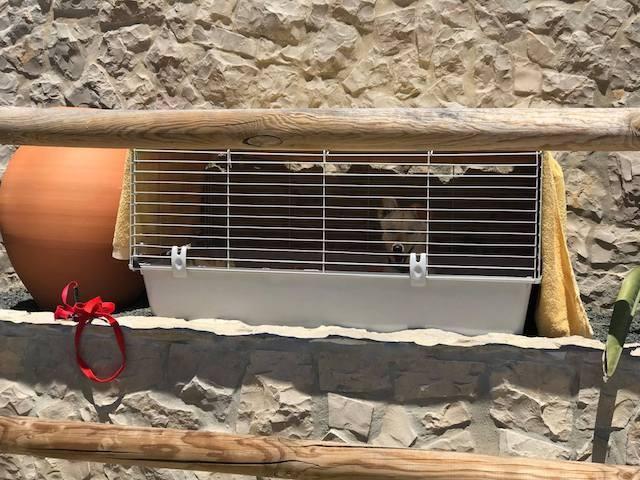
Nowadays, I am able to even walk out of sight and return without Wolfee feeling uncomfortable.
"Happy Place" In Practice
When I'm going to train the horses, Wolfee and I first have a half an hour walk at the beach. That's because, when I don’t provide this, Wolfee’s excess energy in her body might override everything I taught her. When her body is full of energy, her mind cannot relax and focus, and her emotions might go completely out of control, resulting in a restless soul, jumping up and down, barking, and so on. So it's best to prevent this. It's the same with horses: if they cannot move freely and express themselves in the pasture, they might give us a challenging time the first 15 minutes in the riding arena. So we spend some time on the beach first:
Then, when I start training, Wolfee goes into the crate, and because she developed a positive association with it, she quickly falls asleep - even if I pass in canter, she doesn't even wake up. So we don't have to worry that it might be "cruel" to confine a dog in a crate, because it's not when it's done right. Wolfee doesn't perceive it as a "jail cell" - the truth is actually quite the opposite: since dogs have a "denning" instinct, Wolfee really likes her safe, secure, den-like space to relax and rest. When the process of "Happy Place" training is done correctly, and when a crate is used in a certain daily routine, a crate provides structure and a calming and protective space. The same applies to horse boxes, stalls, trailers and other spaces we'd like to put horses in. Of course, an extreme is to put a horse 23h in a box or to lock a dog 23h in a crate, but that's not what I'm talking about here. I'm talking about the benefits of creating structure, a comfortable routine and a safe place. A place where a horse can eat, or a dog can relax and feel secure at those moments we cannot 100% keep our animal under supervision and, for example, we don't want other horses to "steal" our horse's food, or want to avoid that our dog starts chewing on our furniture, pens, or shoes:

Structure helps to prevent challenges, and it provides predictability and peace of mind for both our animals as well as ourselves.
Horses Getting Familiar With "The Happy Place"
Also, the horses had to get used to the 'Happy Place", so that required some "training" as well. So I used some "functional" liberty and invited Romanesque, Prince Elmelund, Toronto and Maestro to check the new setting out. Horses always want to investigate new things by using their senses, and touch, smell, see it, just to check if it's safe and trustworthy. They also had to get used to the noises Wolfee makes - chewing and flipping a toy, moving around in the crate - it all made unfamiliar noises at the beginning which made them prick their ears or raise their neck. So I gave the horses time to figure it out in their own way, and they all settled quickly:
Teamwork Matters
Now it took some time and training to create the "Happy Place" setting, but now everybody is happy for the rest of our lives. So it's worth to invest in this process to avoid separation anxiety, nervous, barking dogs, or stressed horses. And it's worth to take some time for team building, because the difference between success and failure is a great team. If everyone is working together, then success takes care of itself. Now, I made a little video about the whole process, in which you can see the following steps:
- Hanging out together.
- "Happy Place" training with Wolfee.
- The horses getting familiar with Wolfee in the "Happy Place".
- Releasing Wolfee after the training sessions.
I filmed everything myself with my iPhone, and also a bit in an organical way, so the footage is a bit "in your face" 🙃, but I think it gives a solid impression of the process:
Wolfee's Wisdom
With this article, the introduction of Wolfee and the video series comes to an end. 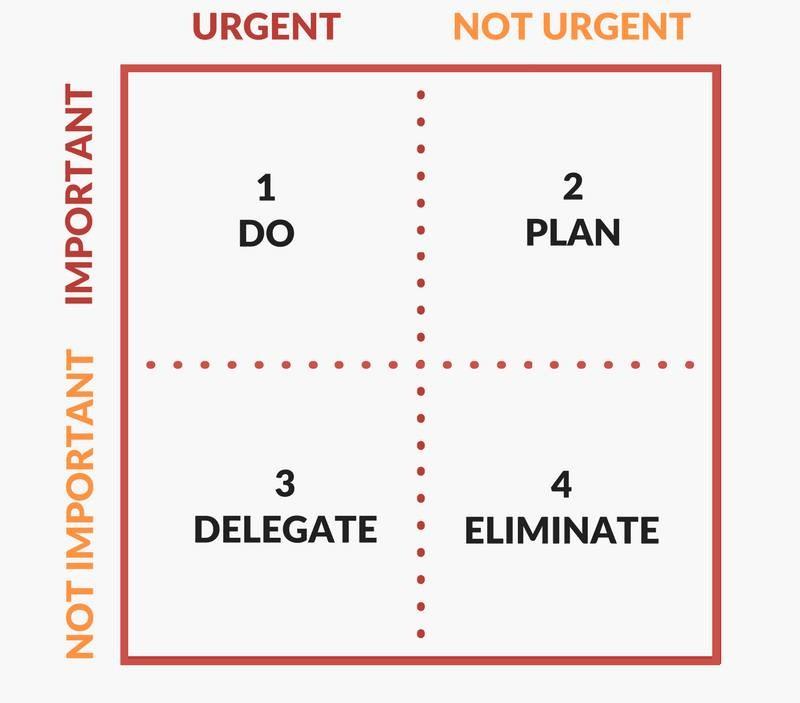 Now some people might wonder why I post this series of "funny dog" videos which seem fall into quadrant 4.... ... but to be clear, it's not just a bunch of videos that are "not important + not urgent". Instead, it's meant to create awareness for the ST principle "Think First, Act Later". It's about a plan for how-to-train-a-young-animal-with-a-challenging-background. And through the series of videos and accompanying articles, you can witness the entire process in practice. Of course, we can watch the Wolfee videos for some feel-good moments, but the 5-part series simply isn’t about that.
Now some people might wonder why I post this series of "funny dog" videos which seem fall into quadrant 4.... ... but to be clear, it's not just a bunch of videos that are "not important + not urgent". Instead, it's meant to create awareness for the ST principle "Think First, Act Later". It's about a plan for how-to-train-a-young-animal-with-a-challenging-background. And through the series of videos and accompanying articles, you can witness the entire process in practice. Of course, we can watch the Wolfee videos for some feel-good moments, but the 5-part series simply isn’t about that. 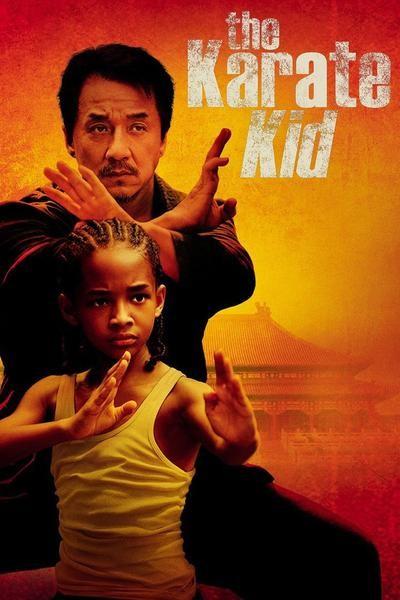 Just like The Karate Kid movie isn’t about Karate, but about using Karate as a vehicle to learn more important things - the Wolfee videos aren't about Wolfee. If you've seen the movie The Karate Kid, you know that when the young kid finally convinces the older master to teach him, he is set on a task of menial chores – wax the car, paint the fence, fauld laundry, and so on. It’s not until the young boy rebels at his activities that the master shows him that what he’d really been doing was learning basic karate skills through the repetitive movements of his basic tasks. Now, in educating Straightness Training (ST), at almost every level, there’s a layer of "wax the car" where I encourage students to read, watch, or do one thing by means of something else that probably seems unrelated. So raising and training a young dog probably seem unrelated to raising and training a horse. But ST doesn't start and end the moment we enter and leave the riding arena. It's a way of life, just as Karate is a way of life: Though the "dojo" training (which is a sort of training in their "riding" arena) is essential in one’s Karate, it is by no means the only place where Karate is practised. Masters must strive to make the practice of Karate part of their everyday lives - from the way they walk, talk, interact, to what they eat. Also, the commitment towards responsibilities are all part of one's Karate and are given as much importance as anything else. And that's what the Wolfee videos are about. As with Karate, Straightness Training is not something you only do in the riding arena. It's not something that only happens while training and riding a horse. It also happens the other 23 hours of the day, when we interact with our dog, bird, cat, kid, husband, family, friends, and so on. In the other 23 hours, we are challenged - and how we deal with those challenges will reflect our horsemanship, for example:
Just like The Karate Kid movie isn’t about Karate, but about using Karate as a vehicle to learn more important things - the Wolfee videos aren't about Wolfee. If you've seen the movie The Karate Kid, you know that when the young kid finally convinces the older master to teach him, he is set on a task of menial chores – wax the car, paint the fence, fauld laundry, and so on. It’s not until the young boy rebels at his activities that the master shows him that what he’d really been doing was learning basic karate skills through the repetitive movements of his basic tasks. Now, in educating Straightness Training (ST), at almost every level, there’s a layer of "wax the car" where I encourage students to read, watch, or do one thing by means of something else that probably seems unrelated. So raising and training a young dog probably seem unrelated to raising and training a horse. But ST doesn't start and end the moment we enter and leave the riding arena. It's a way of life, just as Karate is a way of life: Though the "dojo" training (which is a sort of training in their "riding" arena) is essential in one’s Karate, it is by no means the only place where Karate is practised. Masters must strive to make the practice of Karate part of their everyday lives - from the way they walk, talk, interact, to what they eat. Also, the commitment towards responsibilities are all part of one's Karate and are given as much importance as anything else. And that's what the Wolfee videos are about. As with Karate, Straightness Training is not something you only do in the riding arena. It's not something that only happens while training and riding a horse. It also happens the other 23 hours of the day, when we interact with our dog, bird, cat, kid, husband, family, friends, and so on. In the other 23 hours, we are challenged - and how we deal with those challenges will reflect our horsemanship, for example:
- If our dog pulls on the leash, we should not expect that our horse yields easily to our reins.
- If our dog doesn't like our pressure on the collar, we should not be startled that our horse doesn't accept our pressure on the cavesson noseband.
- If our cat doesn't want to enter a crate, we should not be surprised we have trailer load issues with our horse.
- If we don't sweep the floor in a rhythmical way, we might have difficulties in finding the proper tempo and rhythm with our horse.
- If we threaten our child to take things away, but never do, our kid won't take us seriously, and then we can also expect that our dog will keep doing what he's always doing if we don't follow through.
- If we say to our kid “Oh, don’t do that, sweety, honey, please, will you stop doing that, dear, stop, no, stop it...” we are probably also nagging our horse into good manners.
- If we are parenting by intimidation, it will surely lose its power once our kids grow up, and our mature horse might not respect us either.
- If we give in to our toddlers, our horse has probably begging issues too.
- If we don't give our husband heartfelt compliments, no technical well-executed reinforcement will really touch our horse's soul.
So if we try to create balance for our horse in the riding arena, but do not integrate the same principles and philosophies in other parts of our lives, our horse won't change much as we're just doing some sort of isolated and "empty" activities with our horse.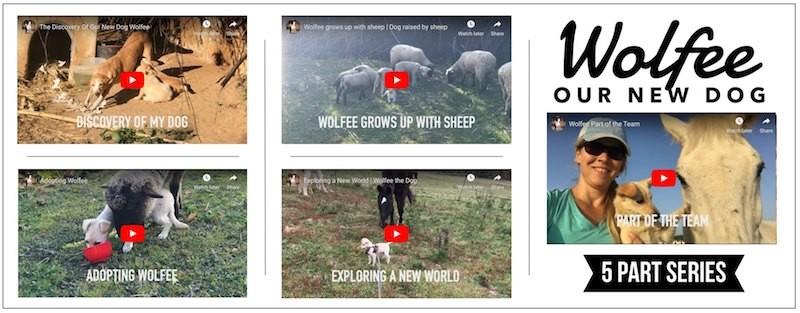
So the Wolfee series isn't about Wolfee, instead, it's about the following:
▶︎ The FIRST part is about not judging at first sight, and the ability to respond to make a long-lasting positive difference for a single "starfish".
▶︎ The SECOND part is about how we can use the inborn curiosity of young animals and their ability to synchronize to prevent vices in mature animals and to avoid horses that are hard to ride and hard to reach.
▶︎ The THIRD part shares another "edge story" that probably seems unrelated to "horses", but the good listener will see that there are no "coincidences" and nothing "just" happens.
▶︎ The FOURTH part is about Wolfee's socialization process. Now you cannot imagine how many students enter our programs with horses that are frightened of "the new": people, places, objects, and activities. Or horses who have developed conditioned fear: horses who don't like men, whips, the cavesson noseband, a specific corner in the riding arena, applause of the public during a clinic, crowded places in general, the trailer, truck, dogs, and so on. Of course, we can come up with a long list of reasons why things aren't going well, but in the end, it's always us. That's what the fourth part is about, and it provides a bunch of concepts to avoid all those issues.
▶︎ The FIFTH part is about crate training and team building. Now, when we skip those "basic tasks" when it comes to horses, we might end up with horses with separation anxiety, horses who are afraid of dogs, horses who are spooky in the same corner of the riding arena every day, horses who doesn't want to load on a trailer, horses who leave the moment we work at liberty, and so on. So again, just like The Karate Kid movie is not about Karate, but about using Karate as a vehicle to more important things, the Wolfee series is not about Wolfee. And I'm glad to receive so many messages by email, on this blog, and on social media from people who are resonating on those important things. People who are aware of the Bigger Picture and really "get it", who clearly see the added value and appreciate Wolfee's wisdom.
Thanks for reading this 5-part series all the way to the end, and many, many thanks for all your inspiring messages!



